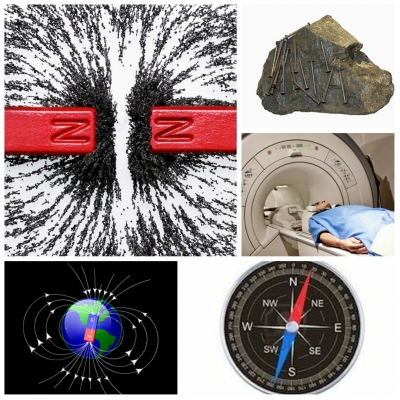
MAGNETISM
Magnetism is an invisible force that attracts (draws towards itself) or repels (pushes away) certain materials. Any object that can attract or repel magnetic materials is classed as a magnet. The area around a magnet that is influenced by its magnetism is referred to as its magnetic field. It is strongest at the “poles” (usually the ends) of the magnet. Opposite magnetic poles will attract each other, while like magnetic poles repel each other. Planet Earth has its own magnetic field, driven by the molten material that circulates beneath the surface.
- MAGNETIC MATERIALS When an unmagnetized magnetic material is placed in a magnetic field it becomes a magnet itself, either temporarily or permanently. Materials such as nickel and iron are easily magnetized and demagnetized and are known as soft magnets. Alloys (mixtures) of iron, nickel, and aluminium are difficult to demagnetize and are referred to as hard or permanent magnets.
- ATTRACTION Iron filings sprinkled around a magnet will reveal the magnetic force field in action. If you bring two magnets together so that a north pole is facing a south pole, then the filings will bridge the gap, showing attraction.
- REPULSION If you bring two magnets together with their two north poles or two south poles facing, you can feel the pushing force between them as their magnetic fields come into contact and the like poles repel each other.
- MAGNETIC STRENGTH The strength of the attraction that holds all these objects together can also be used in industry. Large cranes with a lifting magnet are used to move tonnes of scrap metals and old cars, as well as to load heavy machine parts.
- LODESTONE Nearly 3,000 years ago, people discovered that a strange type of rock could attract iron objects. This rock, called lodestone or magnetite, is a form of iron oxide with strong natural magnetism. The first compasses were made from lodestone.
- MAGNETIC SCAN In a magnetic resonance imaging (MRI) scan, a patient is placed in a magnetic field and radio waves are passed through the body, causing molecules within body tissues to vibrate. Different tissues vibrate in different ways, allowing each part to be seen clearly.
- MAGNETIC EARTH Electric currents circulating inside Earth as the planet rotates cause it to act like a giant magnet, with a magnetic field that extends thousands of kilometres into space. Earth has magnetic poles, which are near, but not the same as, the geographic North and South Poles.
- COMPASS In use from around the 12th century, a compass contains a magnetic needle, which is free to rotate on a pivot. The compass needle will always align itself with Earth’s magnetic field, so that its needle points towards the magnetic north pole.
Picture Credit : Google
